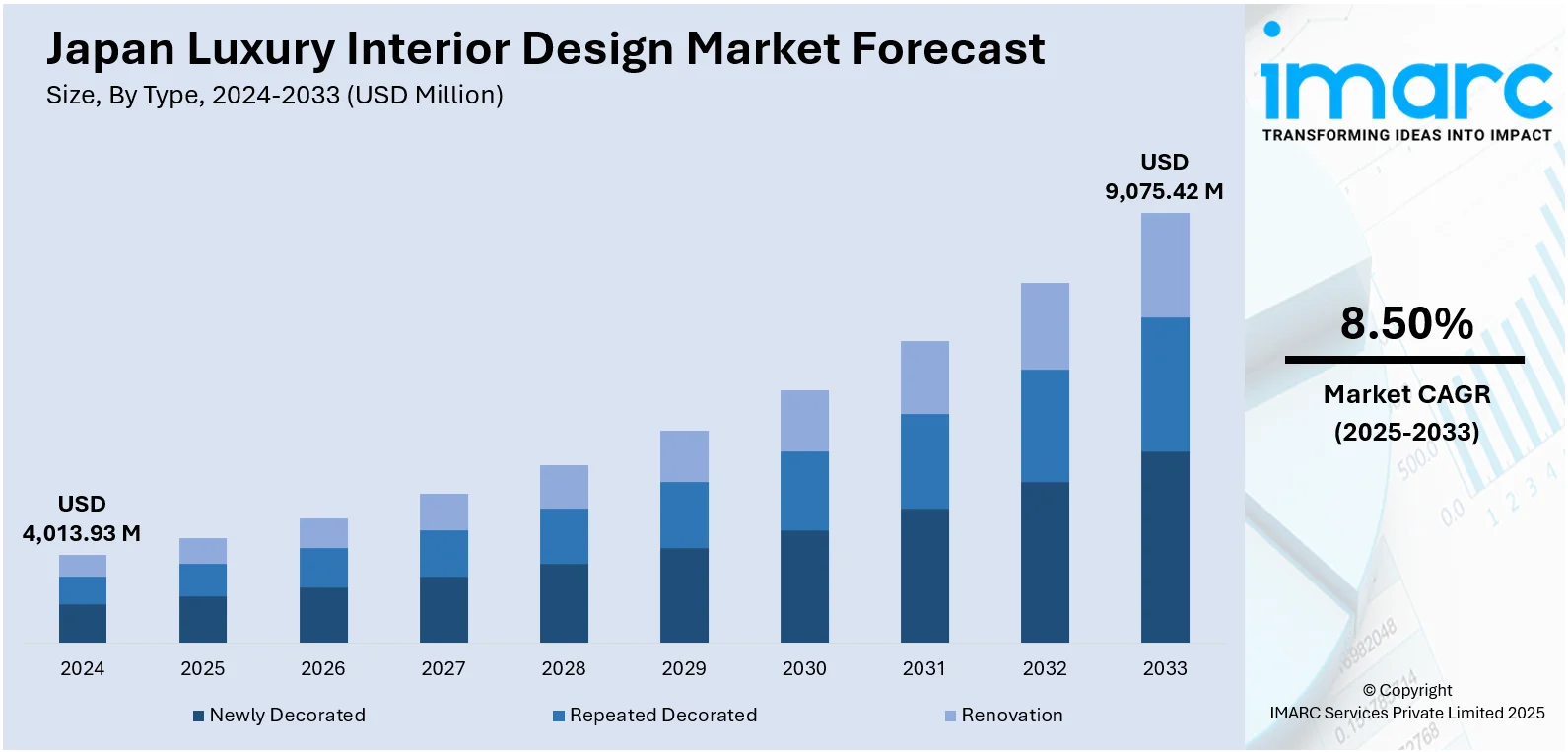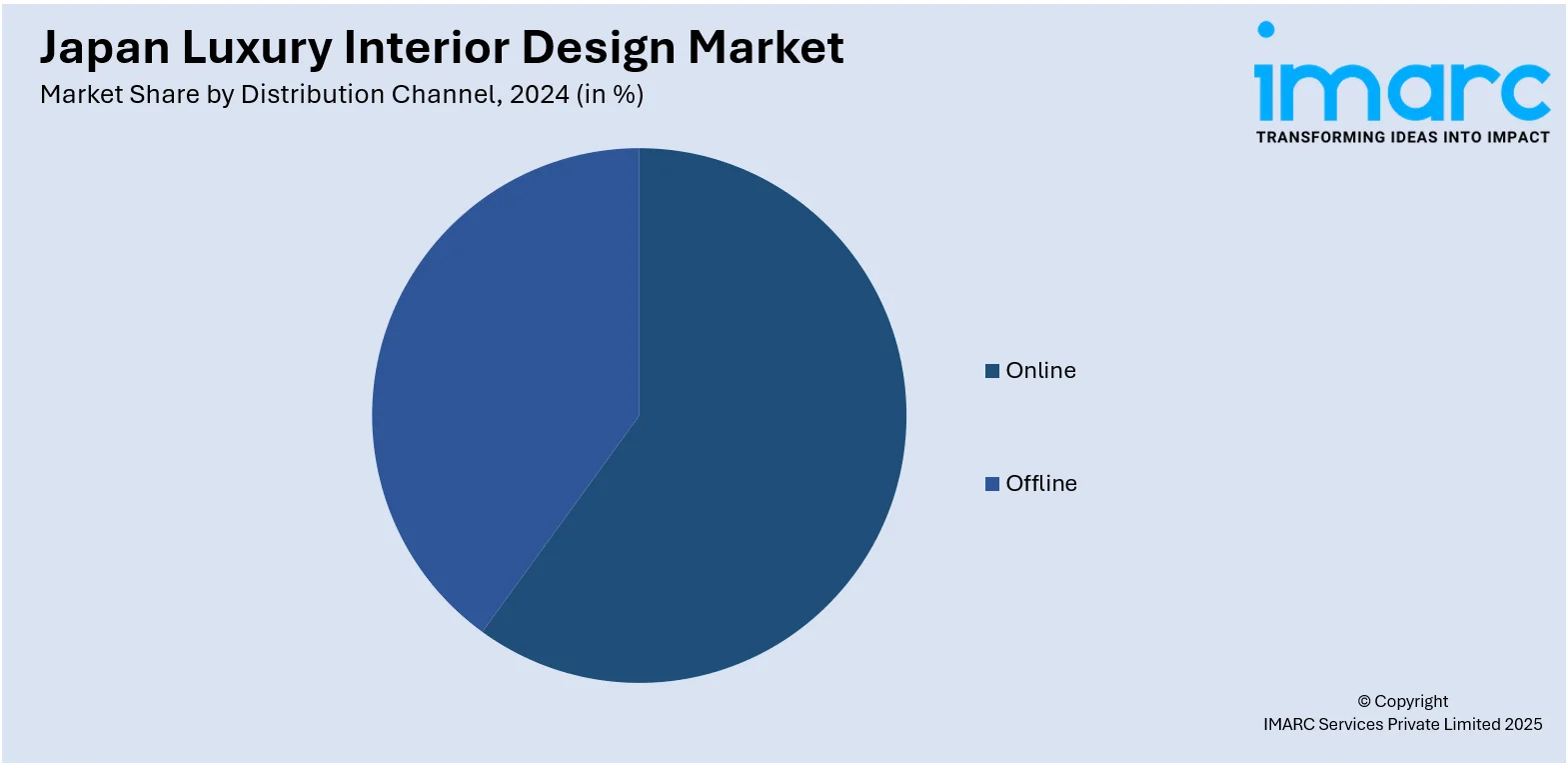
Japan Luxury Interior Design Market Size, Share, Trends and Forecast by Type, Material, Style, Distribution Channel, Application, and Region, 2025-2033
Japan Luxury Interior Design Market Overview:
The Japan luxury interior design market size reached USD 4,013.93 Million in 2024. Looking forward, IMARC Group expects the market to reach USD 9,075.42 Million by 2033, exhibiting a growth rate (CAGR) of 8.50% during 2025-2033. The market is driven by rising urban affluence, strong emphasis on personalized aesthetics, and the integration of smart home technologies. Consumers increasingly seek bespoke, eco-conscious designs that blend traditional craftsmanship with modern innovation. Urban centers like Tokyo and Osaka lead demand, while sustainability and wellness trends reshape high-end interiors, influencing the Japan luxury interior design market share.
|
Report Attribute
|
Key Statistics
|
|---|---|
|
Base Year
|
2024
|
|
Forecast Years
|
2025-2033
|
|
Historical Years
|
2019-2024
|
| Market Size in 2024 | USD 4,013.93 Million |
| Market Forecast in 2033 | USD 9,075.42 Million |
| Market Growth Rate 2025-2033 | 8.50% |
Japan Luxury Interior Design Market Trends:
Emphasis on Sustainability and Wellness
Sustainability and wellness have become central themes in Japan's luxury interior design market. Consumers are increasingly seeking designs that not only exude elegance but also promote health and environmental responsibility. Consequently, designers are choosing sustainable materials, energy-saving mechanisms and plans that let in more natural light and air. Using nature inside homes is growing in popularity since it helps lower stress and improve our well-being. In addition, the choice of eco-friendly materials meets the rising concern for the environment among Japanese people. Such demands are encouraging designers to devise ways to develop elegant spaces that support sustainability and good health.

To get more information on this market, Request Sample
Rising Affluence and Urbanization
Japan's luxury interior design market is significantly influenced by the increasing affluence among its population, particularly in urban centers like Tokyo and Osaka. Rising incomes lead more individuals to prefer luxury spaces that mirror their tastes and social standing. Because of urbanization, there are more high-level residences and offices, which means interior design now requires more expert solutions. Many affluent customers choose to mix design and functionality in their homes by including classic Japanese influences with modern designs. This trend is further fueled by the desire for homes and offices that offer comfort, luxury, and a unique identity, thereby propelling the Japan luxury interior design market growth.
Integration of Smart Technologies
The integration of smart technologies is a significant driver in Japan's luxury interior design market. High-end consumers are increasingly interested in homes and offices equipped with advanced automation systems that offer convenience, security, and energy efficiency. Features such as intelligent lighting, climate control, and integrated entertainment systems are becoming standard in luxury interiors. Additionally, the use of virtual reality and 3D modeling in the design process allows clients to visualize and customize their spaces before implementation. This technological advancement not only enhances the functionality of living spaces but also adds a modern, sophisticated appeal, making smart technology integration a key factor in the market's growth.
Japan Luxury Interior Design Market Segmentation:
IMARC Group provides an analysis of the key trends in each segment of the market, along with forecasts at the country and regional levels for 2025-2033. Our report has categorized the market based on type, material, style, distribution channel, and application.
Type Insights:
- Newly Decorated
- Repeated Decorated
- Renovation
The report has provided a detailed breakup and analysis of the market based on the type. This includes newly decorated, repeated decorated, and renovation.
Material Insights:
- Textiles
- Wood
- Metals
- Glass
- Ceramics
- Plastics
- Others
A detailed breakup and analysis of the market based on the material have also been provided in the report. This includes textiles, wood, metals, glass, ceramics, plastics, and others.
Style Insights:
- Modern
- Traditional
- Rustic
- Vintage
- Classical
- Others
A detailed breakup and analysis of the market based on the style have also been provided in the report. This includes modern, traditional, rustic, vintage, classical, and others.
Distribution Channel Insights:

- Online
- Offline
A detailed breakup and analysis of the market based on the distribution channel have also been provided in the report. This includes online and offline.
Application Insights:
- Residential
- Commercial
- Hospitality
- Retail
- Others
A detailed breakup and analysis of the market based on the application have also been provided in the report. This includes residential, commercial, hospitality, retail, and others.
Regional Insights:
- Kanto Region
- Kansai/Kinki Region
- Central/ Chubu Region
- Kyushu-Okinawa Region
- Tohoku Region
- Chugoku Region
- Hokkaido Region
- Shikoku Region
The report has also provided a comprehensive analysis of all the major regional markets, which include the Kanto Region, Kansai/Kinki Region, Central/ Chubu Region, Kyushu-Okinawa Region, Tohoku Region, Chugoku Region, Hokkaido Region, and Shikoku Region.
Competitive Landscape:
The market research report has also provided a comprehensive analysis of the competitive landscape. Competitive analysis such as market structure, key player positioning, top winning strategies, competitive dashboard, and company evaluation quadrant has been covered in the report. Also, detailed profiles of all major companies have been provided.
Japan Luxury Interior Design Market Report Coverage:
| Report Features | Details |
|---|---|
| Base Year of the Analysis | 2024 |
| Historical Period | 2019-2024 |
| Forecast Period | 2025-2033 |
| Units | Million USD |
| Scope of the Report |
Exploration of Historical Trends and Market Outlook, Industry Catalysts and Challenges, Segment-Wise Historical and Future Market Assessment:
|
| Types Covered | Newly Decorated, Repeated Decorated, Renovation |
| Materials Covered | Textiles, Wood, Metals, Glass, Ceramics, Plastics, Others |
| Styles Covered | Modern, Traditional, Rustic, Vintage, Classical, Others |
| Distribution Channels Covered | Online, Offline |
| Applications Covered | Residential, Commercial, Hospitality, Retail, Others |
| Regions Covered | Kanto Region, Kansai/Kinki Region, Central/ Chubu Region, Kyushu-Okinawa Region, Tohoku Region, Chugoku Region, Hokkaido Region, Shikoku Region |
| Customization Scope | 10% Free Customization |
| Post-Sale Analyst Support | 10-12 Weeks |
| Delivery Format | PDF and Excel through Email (We can also provide the editable version of the report in PPT/Word format on special request) |
Key Questions Answered in This Report:
- How has the Japan luxury interior design market performed so far and how will it perform in the coming years?
- What is the breakup of the Japan luxury interior design market on the basis of type?
- What is the breakup of the Japan luxury interior design market on the basis of material?
- What is the breakup of the Japan luxury interior design market on the basis of style?
- What is the breakup of the Japan luxury interior design market on the basis of distribution channel?
- What is the breakup of the Japan luxury interior design market on the basis of application?
- What is the breakup of the Japan luxury interior design market on the basis of region?
- What are the various stages in the value chain of the Japan luxury interior design market?
- What are the key driving factors and challenges in the Japan luxury interior design market?
- What is the structure of the Japan luxury interior design market and who are the key players?
- What is the degree of competition in the Japan luxury interior design market?
Key Benefits for Stakeholders:
- IMARC’s industry report offers a comprehensive quantitative analysis of various market segments, historical and current market trends, market forecasts, and dynamics of the Japan luxury interior design market from 2019-2033.
- The research report provides the latest information on the market drivers, challenges, and opportunities in the Japan luxury interior design market.
- Porter's five forces analysis assist stakeholders in assessing the impact of new entrants, competitive rivalry, supplier power, buyer power, and the threat of substitution. It helps stakeholders to analyze the level of competition within the Japan luxury interior design industry and its attractiveness.
- Competitive landscape allows stakeholders to understand their competitive environment and provides an insight into the current positions of key players in the market.
Need more help?
- Speak to our experienced analysts for insights on the current market scenarios.
- Include additional segments and countries to customize the report as per your requirement.
- Gain an unparalleled competitive advantage in your domain by understanding how to utilize the report and positively impacting your operations and revenue.
- For further assistance, please connect with our analysts.
 Request Customization
Request Customization
 Speak to an Analyst
Speak to an Analyst
 Request Brochure
Request Brochure
 Inquire Before Buying
Inquire Before Buying




.webp)




.webp)












